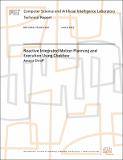Reactive Integrated Motion Planning and Execution Using Chekhov
Author(s)
Shroff, Ameya
DownloadMIT-CSAIL-TR-2013-012.pdf (4.575Mb)
Other Contributors
Model-based Embedded and Robotic Systems
Advisor
Brian Williams
Metadata
Show full item recordAbstract
We envision a world in which robots and humans can collaborate to perform complex tasks in real-world environments. Current motion planners successfully generate trajectories for a robot with multiple degrees of freedom, in a cluttered environment, and ensure that the robot can achieve its goal while avoiding all the obstacles in the environment. However, these planners are not practical in real world scenarios that involve unstructured, dynamic environments for a three primary reasons. First, these motion planners assume that the environment the robot is functioning in, is well-known and static, both during plan generation and plan execution. Second, these planners do not support temporal constraints, which are crucial for planning in a rapidly-changing environment and for allowing task synchronisation between the robot and other agents, like a human or even another robot. Third, the current planners do not adequately represent the requirements of the task. They often over-constrain the task description and are hence unable to take advantage of task flexibility which may aid in optimising energy efficiency or robustness. In this thesis we present Chekhov, a reactive, integrated motion planning and execution executive that addresses these shortcomings using four key innovations. First, unlike traditional planners, the planning and execution components of Chekhov are very closely integrated. This close coupling blurs the traditional, sharp boundary between the two components and allows for optimal collaboration. Second, Chekhov represents temporal constraints, which allows it to perform operations that are temporally synchronised with external events. Third, Chekhov uses an incremental search algorithm which allows it to rapidly generate a new plan if a disturbance is encountered that threatens the execution of the existing plan. Finally, unlike standard planners which generate a single reference trajectory from the start pose to the goal pose, Chekhov generates a Qualitative Control Plan using Flow Tubes that represent families of feasible trajectories and associated control policies. These flow tubes provide Chekhov with a flexibility that is extremely valuable and serve as Chekhov's first line of defence.
Description
MEng thesis
Date issued
2013-06-06Series/Report no.
MIT-CSAIL-TR-2013-012
Keywords
Integrated Planning and Control, Manipulation Planning and Control